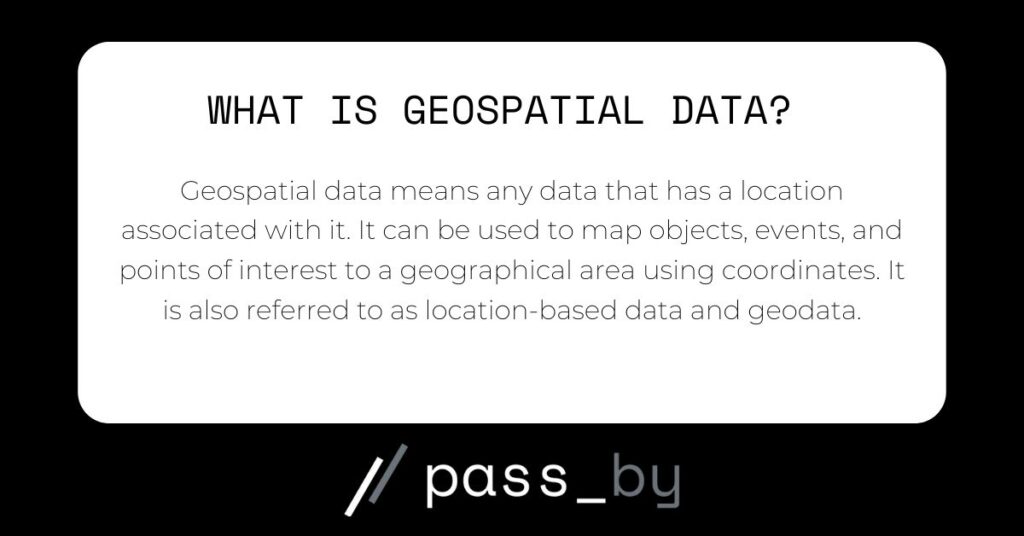Geospatial data empowers businesses and organizations to make informed decisions, understand the rise and fall of sales, and locate opportunities.
Understanding it and how best to use it opens the door to more detailed analysis and understanding of consumer behavior.
At pass_by, we offer geospatial data with the highest in market accuracy with 94% correlation to ground truth, over 15 data inputs, and a full 90 days of predictive feeds. Book a call now.
Here’s everything you need to know about geospatial data analytics:
What is geospatial data?
Geospatial data is any data that has a location associated with it. It can be used to map objects, events, and points of interest to a geographical area using coordinates. It is also referred to as location-based data and geodata.

The two types of geospatial data
The two main types of this data are vector and raster.
| Vector | Raster |
| Uses digital elements to represent locations or features. | Uses a grid of cells to represent information about a location. |
| Often used for physical locations and attributes. | Often used to add information to a map image. |
| Common in navigational, mapping, data visualization, etc. | Commonly displayed alongside a map or as an overlay to provide more detail. |
How is geospatial data collected?
The data is gathered from surveys, remote sensors, GPS, and other technology.
These methods do vary in accuracy, so many data intelligence companies use a mix of methods to gather data to achieve higher reliability. These methods include:
- Global positioning systems
- Drones
- Geographic systems
- Wi-Fi
- Beacons
Global Positioning System
Global Positioning Systems (GPS) are a well-known and established method of collecting location data which geospatial systems then use to map and specify locations.
It calculates the location by receiving signals from satellites in outer space to detect the time it takes from the location or object on Earth to the satellite.
GPS can be accurate to detect and track locations, particularly outdoors under an open sky. The exact accuracy depends on the location of what you’re trying to detect, the conditions, and the device with which GPS is enabled.
Smartphones with GPS enabled are accurate to around 4.9m (16ft).
Drone technology
Drones can be used to collect location data through photography and video. This can then be made into 3D digital models of the area to analyze a land’s condition, environment, and potential use.
Geographic systems
Geographic information systems (GIS) are systems that can visualize, track, and analyze data. GIS often adds tools to help you further analyze the data, such as reports or insights on the local average income, strongest competitors, average foot traffic, and other factors.
Many GIS can further break down changes in the area, such as any rise and fall of foot traffic within a specific time frame.
Wi-Fi
Location signals from Wi-Fi networks can provide accurate geodata indoors. When GPS signals can be obstructed and cell towers are limited, Wi-Fi is an excellent option to pinpoint and provide geodata.
Beacons
Beacons are small battery-powered devices with Bluetooth low energy (BLE) technology. These devices are perfect for indoor use and are commonly used in shopping malls, stores, and warehouses to track the movement of products or assets.
What makes geospatial data unique?
What makes geospatial data unique is its emphasis on location and the context it offers. Being able to pinpoint patterns helps you understand relationships that other data might miss.
For example, identifying high-traffic retail zones can guide your marketing strategies or real estate investments. Additionally, geospatial data allows you to visualize the relationships between different data sets in a way that is more intuitive and impactful.
.These insights are crucial for making informed decisions that drive business success.
What type of data do geospatial technologies provide?
What types of data you receive varies depending on the specialty of the provider and their services.
- Foot traffic data
- Aggregated demographic data on the income and age ranges of a population within a specified area
- Local, regional, and national trend analysis
- Void analysis
What does good data look like?
When buying geospatial data, you need to look for accurate and precise data that fits your needs. To compare accuracy of different providers, look for an accuracy score. If it’s clear and transparent – all the better.
If the provider doesn’t include this information on their website, don’t be afraid to reach out and ask them to provide it so you can make the right choice to achieve your goals.
At pass_by, we offer data that has been rigorously anonymized, stripped from personal identifiers and aggregated around specific points of interest.
The best data is also verified by ground-truth. This means the data we provide is backed up by verified sources at the location.
At pass_by, we offer geospatial data with the highest in market accuracy with 94% correlation to ground truth, over 15 data inputs, and a full 90 days of predictive feeds. Book a call now.
Are accuracy and precision different?
Yes. While accuracy and precision are used in regular speech interchangeably, they mean different things to data scientists.
| Accuracy | Precision |
| Used to understand how close a device’s location is to the geospatial device. | The detail level of the location data. |
| Measurement depends on the signal from the device (beacon, GPS, etc) | Uses latitude and longitude coordinates to check the data points. |
| Has an accuracy rating | Precision varies depending on what you’re trying to measure. |
Having accurate data is important regardless of your business type or goal. How precise you need the data to be can vary. The more decimals the data has, the more precise it is. Data with 6 decimal places are precise enough to gather information on the movement of individuals.
What is geospatial data used for?
A wide range of industries and public sector organizations use location data. Here are seven industries that use geospatial analytics in their day-to-day operations:
- Urban planners: to identify locations for development.
- Real estate developers and investors: discover potential opportunities.
- Mall operators: analyze the mall’s performance, how to improve it and find new tenants.
- Retail businesses: monitor foot traffic and analyze performance.
- Telecommunications: map asset locations.
- Warehouse operators: track assets to manage inventory.
- Marketers: measure the success of specific marketing campaigns to increase foot traffic within a certain area.
Why is geospatial data important?
Geospatial data enables you to model the real world, often within real time. Accurate predictions lead to better decision-making – When you study a phenomenon over time in the context of a particular location, you begin to better understand why it happens where and when it does.
1. Improve efficiency
Businesses can improve operational efficiency using data. For example, retail stores can use geospatial data to see the busiest hours of store operations and adjust open hours and the number of staff as needed.
2. Complete competitor research
Geodata can inform businesses about competitor performance, including the top ranking stores within the same industry at a local, regional, national and global level with up-to-date highly accurate information.
3. Predict performance
Some GIS include Artificial Intelligence (AI) to ensure data precision calculations and predict future data sets, such as the level of footfall you could expect in the next few months. AI is still developing and what insights it can give is growing everyday.
Geospatial data challenges
Geospatial data can offer vast amounts of raw data, insights, and reports which can be challenging to analyze at its full potential.
Amount of data
Data intelligence companies generate millions of data points everyday. At pass_by, we process over 6 billion data points from over 15 sources.
Receiving this data in raw form can be done by sending it to the cloud for companies to then analyze in house. However, this method can be difficult for some companies due to lack of time or experience.
When the amount of data is an obstacle, visualization is the solution. Data visualization systems such as Almanac can display the data on a map, analyze it for you, and offer further insights.
Limited accuracy
What the data sources will greatly vary the overall accuracy of the data you receive. When using data provided by an intelligence service, check the data policy, methods of collection, correlation score, and sources.
The more varied the data sources, the more accurate the data can be as any gaps are filled in by another source of collection.
Next, look for ground-verified data. While location data from GPS, Wi-Fi and other sources can be accurate, data that’s been ground verified is reliable. It is also called ground truth. This is data that has been checked and verified from direct observation and measurements at the specified location.
Ethical considerations
When dealing with geospatial data, it’s critical to understand the ethical considerations. This includes data protection laws that exist to protect consumers. Whether you’re a data collector, user, or business, awareness of these considerations isn’t just about compliance—it’s also about fostering trust and respect between parties dealing with sensitive location-based information.
Data intelligence services must provide compliant data that respects privacy. When speaking to your data provider, ensure the data provided is compliant with the relevant laws for your business, such as:
- General Data Protection Regulation (GDPR)
- California Consumer Privacy Act (CCPA)
What is geospatial analytic?
Geospatial analytics means analyzing location-based data such as Points-of-Interest, foot traffic, and demographics of visitors. Analytics is essential to visualize the data; this can include graphs, maps, and other platform tools to display changes overtime.
Geospatial analytics offers a multi-dimensional perspective, enabling organizations to interact with their surroundings more intuitively and strategically. Its applications are broad, making it a crucial tool in the modern business landscape, enhancing both operational and strategic capabilities.
What is the future of geospatial data?
Data analysis is making great strides to support businesses and other organizations in achieving their goals. GIS now has a consistent role in supporting various sectors, including health, finance, retail, and real estate.
The future looks promising for spatial data as methods of data collection grow and become more precise. One major trend no one can miss is the wave of machine learning (ML) within GIS to make predictions about the data, giving businesses a greater edge and control over operations.
Is the geospatial data industry growing?
Yes. The global geospatial analytics market is projected to reach a value of $134.48 billion by 2025. This growth is driven by more businesses using network and location analytics to research their industry, reduce operational costs, and analyze footfall trends.
Machine learning for geospatial data: can it help?
Machine learning refers to AI that learns from a data set and can provide predictions on what data could follow. With time and enough data, the machine learning model can predict things and find patterns that a human either couldn’t or would take longer to complete.
Other than predictive insights, machine learning is also capable of:
- Classifying: categorize data.
- Clustering: cluster data into groups that have similar properties.
- Regression: find a relationship between multiple variables.
At pass_by, we offer geospatial data with the highest in market accuracy with 94% correlation to ground truth, over 15 data inputs, and a full 90 days of predictive feeds. Book a call now.
Frequently asked questions
What are the three characteristics of geospatial data?
Data of this type includes three characteristics:
- Location: the coordinates
- Attribute: the characteristics
- Temporal: the time of the data
What are geospatial data tools?
Geospatial data tools are a term used to describe a range of modern technologies that contribute to a larger system of mapping and data analysis. These tools can include a map visualization tool and AI analysis.
Is Google Earth a GIS?
No, Google Earth is not a Geographic Information System (GIS). It is easier to use than those types of systems and is simply an open-sourced mapping platform to navigate the Earth’s surface from outer space to Earth’s streets.
What makes geospatial data unique?
Geospatial data does something unique: it takes time and space metrics and uses them to provide context a human can understand intuitively. Time and space are important metrics we use to measure the world and so spatial data is widely applicable across industries, organizations, and goals.





